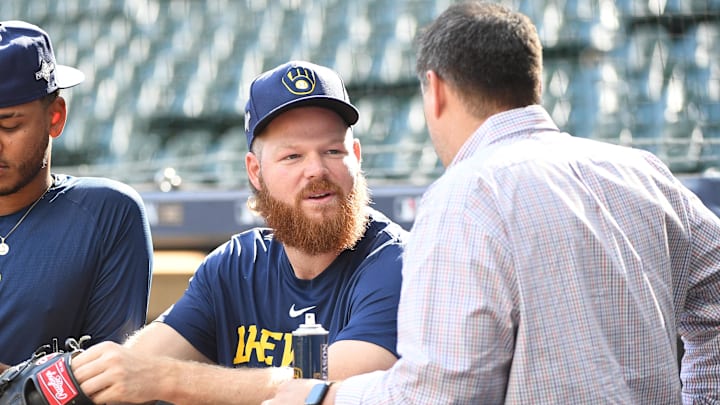Brandon Woodruff's long-awaited return to a big-league mound couldn't have gone better. After nearly two seasons away from the major leagues, Woody ironically returned to the same mound that he made his last start on back in 2023 at loanDepot Park in Miami. His highly efficient six-inning start has Milwaukee Brewers fans excited about what he can bring to an already solid 2025 Brewers starting rotation. Though expectations should maybe be tempered, one thing remains clear: Brandon Woodruff can still pitch at an elite level.
The experience and leadership that Woody brings to the Brewers rotation add value beyond the lethal four-seam-sinker combo that the veteran right-hander displayed yesterday afternoon. Especially next year, as veterans Nestor Cortes and José Quintana likely depart in free agency, having a clubhouse presence like Woodruff for the Brewers’ otherwise inexperienced starting rotation would be huge. Luckily for the Brewers and Woodruff, his contract includes an option that could benefit both sides.
Brewers could look to exercise Brandon Woodruff's $20 million mutual option this winter
Woah, woah, woah. $20 million? On the Brewers’ payroll? There's no chance. More context is required, but first, let's break down what a mutual option is. Often included at the end of MLB contracts are one of three options: a player option, a club option, or a mutual option. The three are relatively self-explanatory; for a player option to be exercised, only the contracted player in question needs to agree to it, for a club option, only the team needs to agree to it, and for a mutual option, both parties must agree on the contract. For example, the Brewers held a club option for Freddy Peralta this season worth $8 million — an easy decision as the going price for an All-Star starting pitcher is much higher than that. On the flip side, Rhys Hoskins exercised his $18 million player option this offseason because he didn't think he could get a higher salary by declining it and hitting the open market after his down season in 2024.
Mutual options are hardly ever picked up. In fact, one of the most recent instances of a mutual option being picked up by both sides was in 2015, when the Brewers and Aramis Ramírez both agreed to a $14 million salary — that was 10 years ago. Mutual options are agreed upon at the time of the initial contract signing, and it's hardly ever the case that the agreed-upon number is a perfect representation of the player's value when the option is available several years later. Additionally, mutual options are generally used as a way to defer money to a later year, as the alternative to a mutual option is a "buyout." Buyouts are generally a fraction of the mutual option and allow the player to become a free agent if they are chosen.
Yes, Brandon Woodruff holds a $20 million mutual option for 2026 in his contract, but it's tied to a $10 million buyout. In other words, one way or another, the Brewers will be paying Woody $10 million next season. For an extra $10 million, they could have him in their starting rotation. When viewed that way, Woody's $20 million mutual option doesn't seem as daunting for the Brewers, assuming he continues to pitch as he did in his first game back.
For Woodruff, agreeing to the mutual option would allow him to stay in Milwaukee for an extra year — a place that he clearly feels comfortable in — and continue to get stronger before hitting the open market after next season. Woodruff will turn 34 in the 2026-27 offseason and could secure a big multi-year contract if he proves that he's healthy and effective with a full season in Milwaukee in 2026. Additionally, a $20 million salary would be the biggest of his career by a wide margin.
It's obviously far too early to make a decision, and there's even a chance that the two sides negotiate a different contract, but when it looks like there's at least a chance that a mutual option could be exercised, it's worth noting, as the contract stipulation is hardly ever agreed on. More than anything, Brewers fans just want to continue to watch number 53 carve up opposing lineups for several years to come.
